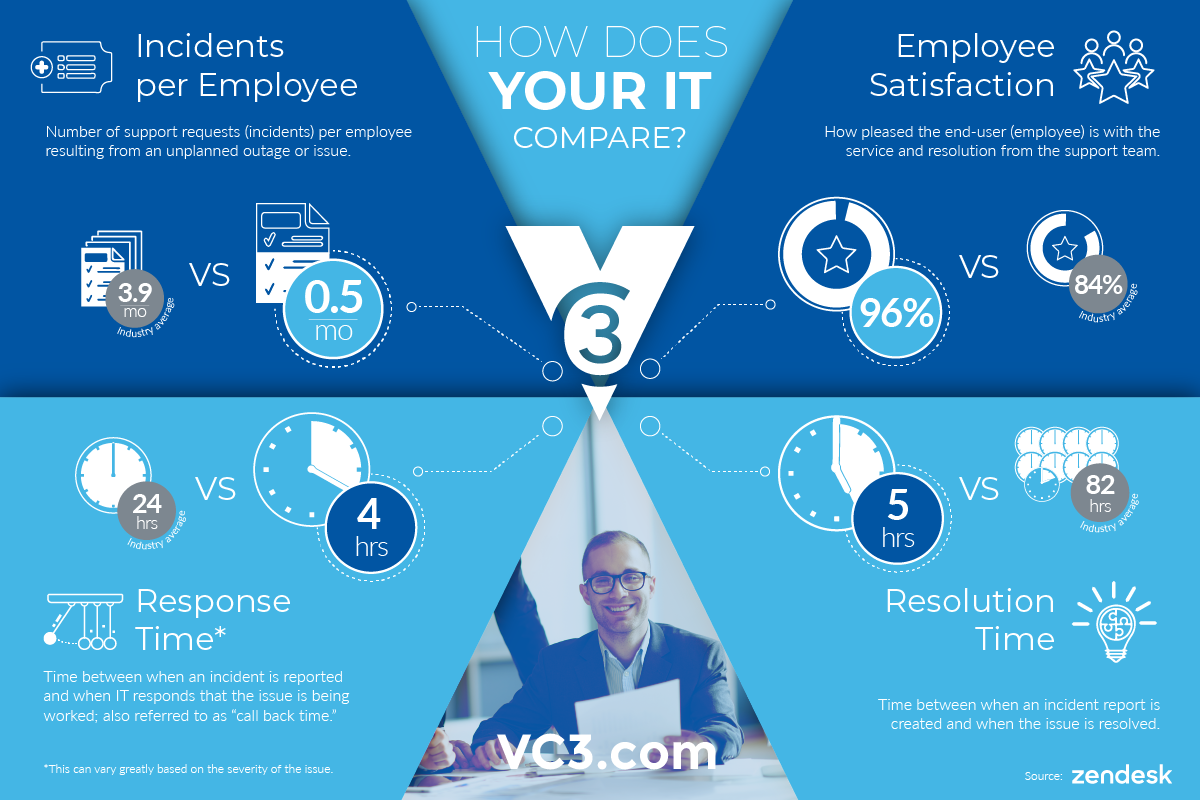Think back to your elementary school days. Perhaps you were one of the lucky kids who wore glasses. Do you remember what it was like trying to read the board before you got glasses? Fuzzy, out of focus, and hard to read come to mind. You may have thought it looked that way for everyone. But then you got glasses and realized it wasn’t supposed to be that way! The writing was clear, and you could read it.
What does wearing glasses and fuzzy writing on a board have to do with IT? Well, underperforming IT is similar to trying to read the board without glasses. Until it’s clearly in focus, you don’t realize how good your IT could be.
Bring Your IT Into Focus
Whether you have an IT department or work with a partner, IT is critical in supporting your organization’s goals. IT should be working for you, not the other way around.
But how do you know if your IT is really working? What should you look at, and what metrics can you use? We’ll look at how you can measure IT performance and factors to consider when optimizing your IT.
Related Reading - IT Budgeting: Top Six Mistakes When Cutting IT Costs and Alternatives
IT Performance Metrics
As the saying goes, “numbers don’t lie,” and that is true when it comes to your IT performance metrics. After working with over 360 organizations as their strategic IT partner, we see three common themes with IT performance metrics:
- No one keeping track.
- Don’t know what metrics to track.
- Don’t know how to track the metrics.
It is understandable why this happens - you are focused on growing your organization not on how well IT is working. However, a strategic IT team can help push your business forward.
Let’s get a little technical for a moment. There are a handful of items you should track to ensure that your IT is reliable. Where applicable, we’ve included the industry average in addition to where VC3 ranks.
Incidents per Employee
Number of support requests (incidents) per employee resulting from an unplanned outage or issue.
Industry average is 3.9 incidents per employee per month; VC3 averages .5 per employee per month for our clients.
Response Time
Time between when an incident is reported and when IT responds that the issue is being worked; also referred to as “call back time.”
This can vary greatly based on the severity of the issue. Industry average is 24.2 hours and VC3 averages 4.3 hours.
Resolution Time
Time between when an incident report is created and when the issue is resolved.
Industry average is 82 hours and VC3 averages 5.6 hours.
Satisfaction
How pleased the end-user (employee) is with the service and resolution from the support team.
Industry average is 84% and VC3 averages 96% satisfaction.
 There are some additional metrics you want to track. These will give you a good idea of how your IT is impacting your overall business.
There are some additional metrics you want to track. These will give you a good idea of how your IT is impacting your overall business.
- Downtime: Unscheduled time a tool or equipment is down and unable to be used.
- Unusable Labor Time: Time and associated dollars lost when an employee is unable to perform their job due to an IT issue.
- Tickets Open versus Closed: Number of tickers that are open versus being resolved and closed. This metric often requires some additional digging to understand what the numbers mean.
- Time to Resolve: Similar to resolution time but also accounts for both the number of hours-per incident and how many tickets are being resolved.
- Cost per Ticket: Total monthly operating expenses of the support team divided by the number of tickets in a month.
No matter what metrics you track, it is crucial to keep this in mind – understanding your metrics and trends means digging for the root cause. What do I mean? Too often, organizations get stuck in a cycle of recurring IT issues. Until you stop and analyze why the same issues are happening, each resolved ticket is simply a short-term bandage fix.
But what if you outsource IT? Your IT partner should be providing you timely, meaningful reports around the metrics above. It’s important that these reports are more than eye charts and the data is explained and discussed.
Related Reading - Remote Work: Maintaining Team Visibility with Microsoft Planner
IT Performance Management
Whether you have an internal IT department or outsource, regular touchpoints should be taking place. If meetings are not currently taking place, the first step is to establish a regular meeting cadence. At a minimum, you should be meeting at least once a month.
The meeting audience is also important. If your IT is internal, you want internal stakeholders along with IT management to attend. If you outsource your IT services, attendees may include your Virtual Chief Information Officer and the internal IT contact.
For larger organizations, consider an IT steering committee. IT touches every aspect of your organization, and it’s important to know what projects may be coming up. This collaborative communication is key to building a meaningful IT strategy.
IT Performance Audits
Audits are commonplace with finance and accounting. Organizations regularly bring in an outside company to audit their financial files and numbers. However, that’s not always the norm when it comes to IT. If you have an outsourced technology partner, they should be recommending a third-party audit. A reputable technology provider should have no problem having their work reviewed by another group.
Your external IT partner should put your organization’s best interest first. What does that mean? If there is a product or vendor that’s better suited to your needs, they should recommend it. Or at the least, present it as an option.
Conversely, if you have an internal IT department, don’t hesitate to have an audit performed. Many managed service providers offer audit services. Just like you wouldn’t have your CFO audit your finance department, you don’t want your IT director to audit the IT department.
Final Thoughts
Technology touches every aspect of your organization. It must align with your organization’s goals and drive value. Collaborate with a strategic technology partner. This offers you more freedom to focus on other aspects of your organization. There are a lot of things to consider when making this move, and a strategic technology partner can provide the guidance needed. Your IT partner should not feel like a third-party vendor. Rather, your IT partner should feel like part of your organization.
If you’re unsure if your organization’s IT is creating value, supporting organizational goals, and working for you, it may be time to consider a strategic IT partner. We can examine where you are today, where you want to be tomorrow, and work with you to build a roadmap to get there.
If you're looking to improve reliability and gain a strategic IT partner, we'd love to connect with you. Fill out the form below and we'll schedule a call to discuss your organization and its goals.





